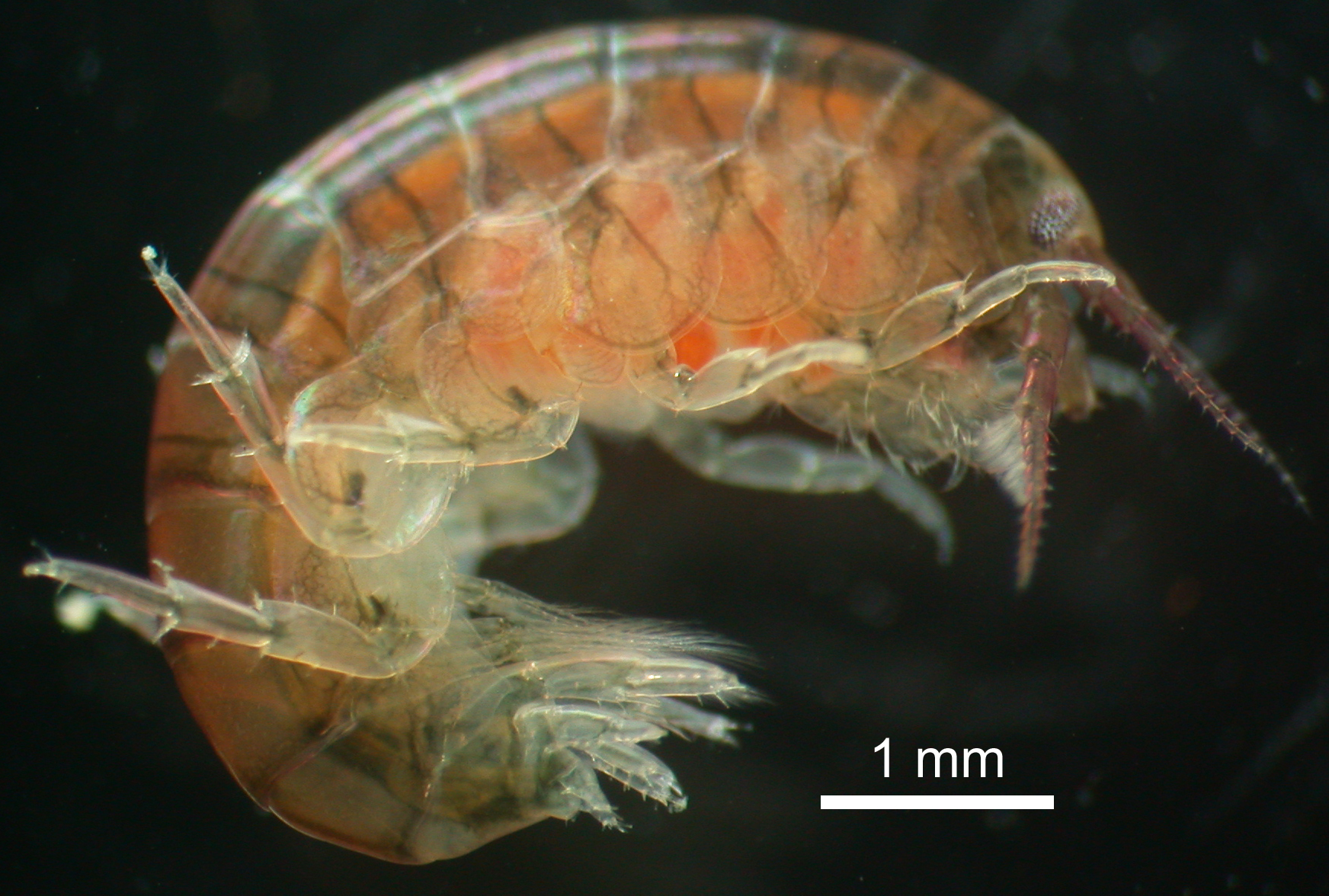A gammaridean amphipod was obtained intertidally in Oshoro Bay, Hokkaido, Japan, about 43°21′N, 140°85′E, on 3 June 2013 by Koutarou Tamura and Azusa Nakamoto. It was photographed by Hiroshi Kajihara with a Nikon COOLPIX 995 digital camera and fixed in 99% EtOH. Based on the digital images, it was later identified by H. Kajihara as Ptilohyale barbicornis by a reference to Hirayama (1995); the generic affiliation of the species followed that of Bousfield and Hendrycks (2002). Total DNA was extracted from posterior half of the body using the silica method (Boom et al. 1990) with some modifications. Extracted DNA was dissolved in 30 µl of deionized water and has been preserved at –20°C. Remaining morphological voucher specimen has been deposited at the Hokkaido University Museum under the catalogue number ICHU2111068 (contact: Dr. Hiroshi Kajihara, kazi@mail.sci.hokudai.ac.jp).
An about 1.3K-bp fragment of the 28S rRNA gene was amplified by polymerase chain reaction (PCR) using the primer pair LSU5 (5′-ACCCGCTGAAYTTAAGCA-3′) and LSU3 (5′-TCCTGAGGGAAACTTCGG-3′) (Littlewoodet al. 1994). A hot start PCR was performed by a 2720 Thermal Cycler (Applied Biosystems), in a 20-µl reaction volume containing 1 µl of template total DNA (approximately 10–100 ng) and 19 µl of premix made with 632-µl deionized water, 80-µl Ex Taq Buffer (TaKara Bio), 64-µl dNTP (each 25 mM), 8-µl each primer (each 10 &micrl;M), and 0.1-µl TaKara Ex Taq (5 U/µl,TaKara Bio). Thermal cycling condition comprised an initial denaturation at 95°C for 30 sec; 30 cycles of denaturation at 95°C for 30 sec, annealing at 45°C for 30 sec, and elongation at 72°C for 45 sec and a final elongation at 72°C for 7 min. Prior to this, we failed in PCR amplification of the mitochondrial cytochrome c oxidase subunit I gene using LCO1490 (5′-GGTCAACAAATCATAAAGATATTGG-3′) and HCO2198 (5′-TAAACTTCAGGGTGACCAAAAAATCA-3′) (Folmer et al. 1994).
The PCR product was purified with the silica method (Boom et al. 1990). Both strands were sequenced with a BigDye® Terminator v3.1 Cycle Sequencing Kit (Applied Biosystems) following the manufacturer's protocol, using the same primer set as the initial PCR amplification in addition to two internal primers: D2F (5′-CTTTGAAGAGAGAGTTC-3′) (Littlewood 1994) and 28z (5′-CTTGGTCCGTGTTTCAAGAC-3′) (Hillis and Dixon 1991). Sequencing was performed with ABI Prism 3730 DNA Analyzer (Applied Biosystems). Chromatogram and sequence data were operated with MEGA v5 software (Tamura et al. 2011).
Results
A total of 1292 bases of 28S rDNA sequence was determined from Ptilohyale barbicornis (see Appendix).
Taxonomy
Phylum Arthropoda
Subphylum Crustacea
Class Malacostraca
Order Amphipoda
Family Hyalidae Bulycheva, 1957
Genus Ptilohyale Bousfield and Hendrycks, 2002
Ptilohyale barbicornis (Hiwatari and Kajihara, 1981)
[Japanese name: husage-mokuzu]
(Fig. 1)

Fig. 1. Ptilohyale barbicornis, ICHU2111068, photograph taken in life.
References
Boom, R., Sol, C. J. A., Salimans, M. M. M., Jansen, C. L., Wertheim-van Dillen, P. M. E., and van der Noordaa, J. 1990. Rapid and simple method for purification of nucleic acids. Journal of Clinical Microbiology 28: 495–503.
Bousfield, E. L. and Hendrycks, E. A. 2002. The talitroidean amphipod family Hyalidae revised, with emphasis on the North Pcific fauna: systematics and distributional ecology. Amphipacifica 3: 17–134.
Folmer, O., Black, M., Hoeh, W., Lutz, R. and Vrijenhoek, R. 1994. DNA primers for amplification of mitochondrial cytochrome c oxidase subunit I from diverse metazoan invertebrates. Molecular Marine Biology and Biotechnology 3: 294–299.
Hillis, D. M. and Dixon, M. T. 1991. Ribosomal DNA: molecular evolution and phylogenetics inference. Quarterly Review of Biology 66: 411–453.
Hirayama, A. 1995. Amphipoda. Pp. 172–205. In: Nishimura, S. (Ed.) Guide to Seashore Animals of Japan with Color Pictures and Keys, Vol. II. Hoikusha, Osaka.
Littlewood, D. T. 1994. Molecular phylogenetics of cupped oysters based on partial 28S rRNA gene sequence Molecular Phylogenetics and Evolution 3: 221–229.
Tamura, K., Peterson, D., Peterson, N., Stecher, G., Nei, M., and Kumar, S. 2011. MEGA5: molecular evoltinary genetics analysis using maximum likelihood,evolutionary distance,and maximum parsimony methods. Molecular biology and Evolution 28: 2731–2739.
Appendix
28S rDNA partial sequence (1292 bases) from ICHU2111068, identidied as Ptilohyale barbicornis, collected in Oshoro Bay, Hokkaido, Japan.
AGGGCGACTTGAACAGGGAAGAGCCCAGCGCAGAACCTCCCGGGCCTAACAGCCTGCGGCGGAATGTTGCGTTAAGGGAAAGGTCGCTTTTAAACCCCACAGCCACGCGATCGCTAAGTCCTGCCACGAGTGGCGTTCCCGACGAAAGGAGGGATTGTGGCGCCGTGGAGGGTGACAGTCCCGTGTGGACGCGTGCGATTTGCTGTGCGAGGGTGAGGCCTTTTTCCCTGTGAGTCGCGTTGCTTGCACATGCAGCGCTAAGCAGGTCGTAAACTCGATCTAAGGCTAAATACATCCACAGAACCGATAGTGAACAAGTACCGTAAGGGAAAGTTGAAAAGAACTCTGGAGAGAGAGTCAAAAGACCGTGAAACCGCTCAGAGTATAAGCCGATGGCGCTGGAAGGCAACCGGTGGCACGGTGCGCCGGGCTTCGGTCCGGAGTGCCCAAAATGCCCGAGTTTGAGGTTAGTTGCGGGAAGTAGCAATGCGCTGCTTCTCCGTCAGGCGGGCTCGTGCGGAGCAGCACCCTCGGTGTCGTTTCTGTCGGGTTCGTGCTGGACGATTCTCTCGGGGCATCACACGGTCATTGCCCACCACAGCCCGTTGCTTGGTCACCCGCTGGGTCTTGATGTGCAGAAGCTTCATCTGGGTCGCGTTGGCGTGCGTGTGTTGGGCGATGCCTTTGCTCTGCTTCTGTGGGGCTGGGCACGTCCGCGCGCTCTTCGTGCACTCAGCTCTGACTGCCGACTTGGACGTGGTGTGATCCACTCGGCGACGGTGCTGCAATTGGTCAGACGTATACAACCCCAGCTCCGCTGCCATGTGCCGGTGGCGGAGTACCTGCGGGCCGGCTGCTTGCGTCGCATGCTAAAGCATACGCTCAGCCTGGGAGTTGGTCTGTCTGGTGATGCTCTAGCGACCATCGGTCACGTCTCGAAACACGGGCCAAGGAGTATAGCATGTGTGCGAGTCTAAGGGTCTCACAAAACCCGAGGGCAAAGTGAAAGCAAAGGTGTGGCGGCGCTTGCGCCGTCAGCCAACTTTGTTGGTTGCTAGTACCGAGCTGATCCCGATTTCCCATGCTGGGGACGGGCGCAAGCTCCGGGCTCACATTTGTTGTTCGGCAACCTCTCCTCGTGGGTGGTGGCTGGACGGTGAGCACTGCGGAGCACATATGCTATGACCCGAAAGATAGTGAACTATGCCTGGCGAGGGTGAAGCCCCAGGAAACTGGGGTGGAGGCCCGTAGCCGTTGTGACGTGCAAATCCATGGCGTCAGTTGGGCATAGG